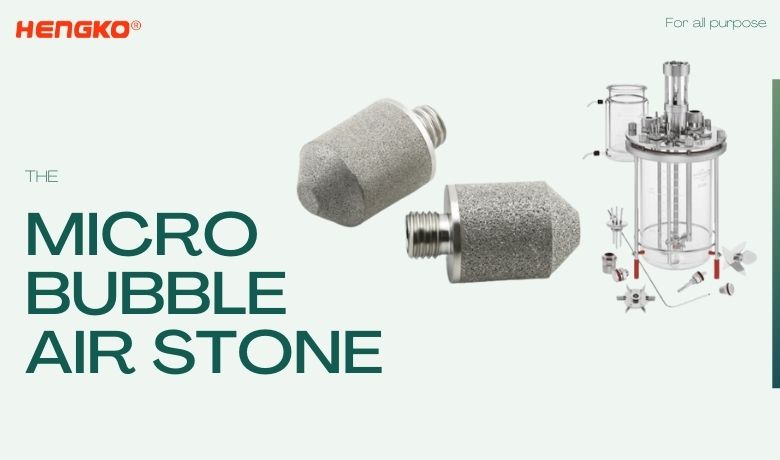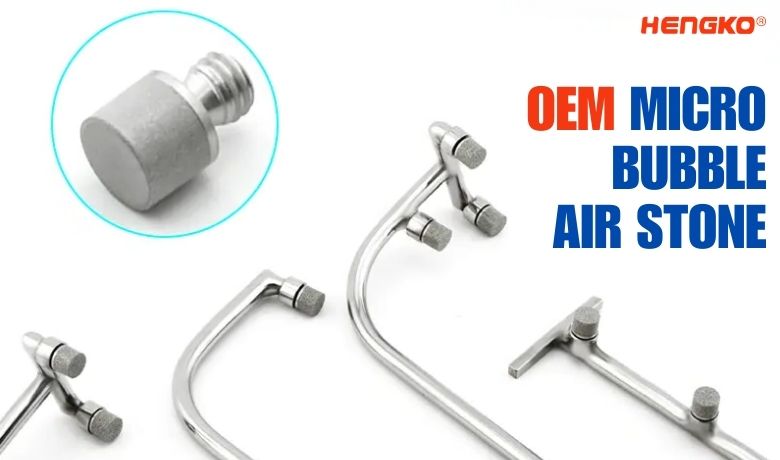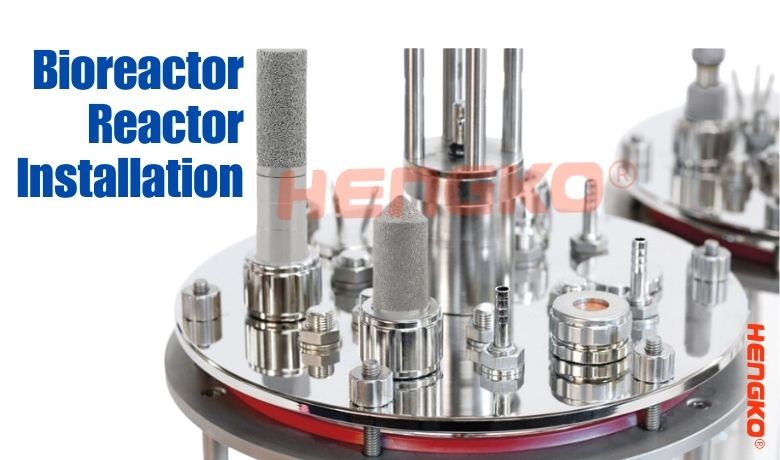
In Short, A micro-bubble air stone is a device and designed to create a multitude of very small bubbles, commonly referred to as "micro-bubbles," when air or gas is forced through the stone's porous structure., main used in various applications, such as aquariums, bioreactors, aquaculture systems, and water treatment plants, to introduce aeration and dissolved oxygen into a liquid medium.
The micro-bubble air stone is typically connected to an air pump or a gas source. When the air or gas passes through the tiny pores or slits of the stone, it gets broken down into numerous fine bubbles. These micro-bubbles rise through the liquid, providing efficient oxygen transfer and aeration to the surrounding environment.
Some Main Features and Advantages of Micro-bubble Air Stones You Should Care :
1. High Oxygen Transfer Efficiency:
The production of micro-bubbles increases the gas-liquid interface area, promoting highly efficient transfer of oxygen or other gases into the liquid. This is especially crucial for sustaining biological processes, such as cell culture, fermentation, and the health of fish or aquatic life in aquariums.
2. Uniform Dissolved Oxygen Distribution:
Micro-bubble air stones ensure even distribution of dissolved oxygen throughout the liquid medium, preventing localized oxygen depletion and supporting consistent growth and performance of biological organisms.
3. Gentle Aeration:
The small size of the micro-bubbles and their gentle rise through the liquid result in minimal disturbance to the surrounding environment, making it suitable for delicate applications like aquatic habitats and bioreactor cultures.
4. Contamination Prevention:
The use of air stones allows for the introduction of clean, filtered air or gas into the liquid medium, minimizing the risk of contamination and maintaining a sterile environment in bioreactors and other controlled systems.
Micro-bubble air stones come in various shapes and materials, such as porous ceramic, glass, plastic, or sintered metal. The choice of the specific type of air stone depends on the application, the size of the system, and the desired level of aeration and oxygenation needed for the particular environment. These air stones play a crucial role in maintaining optimal conditions for biological processes, supporting aquatic life, and improving water quality in various industries and settings.
Types of Micro Bubble Air Stone?
Micro-bubble air stones come in various types, each designed to suit different applications and requirements. Here are some common types of micro-bubble air stones:
1. Porous Ceramic Air Stones:
These air stones are made from a porous ceramic material that allows air to pass through tiny pores, creating a multitude of micro-bubbles. They are durable, easy to clean, and suitable for various sizes of bioreactors and aquariums.
- Application: Porous ceramic air stones are versatile and suitable for various applications, including aquariums, hydroponics, and small to large-scale bioreactors.
- Advantages: They are durable, long-lasting, and easy to clean. They can withstand exposure to different chemicals and pH levels commonly found in bioreactor and aquarium environments.
2. Glass Air Stones:
Glass air stones are made of glass, and they have small pores or slits that produce micro-bubbles. They are often used in small-scale applications like aquariums and hydroponic systems.
- Application: Glass air stones are typically used in small-scale applications like aquariums and hydroponic systems.
- Advantages: They are aesthetically pleasing and produce fine micro-bubbles, suitable for oxygenating smaller volumes of water.
3. Plastic Air Stones:
Plastic air stones are affordable and widely used in aquariums and fish tanks. They come in various shapes and sizes and are known for producing fine micro-bubbles.
- Application: Plastic air stones are commonly used in aquariums and fish tanks.
- Advantages: They are affordable, lightweight, and provide a good balance of performance and cost-effectiveness for small-scale aeration needs.
4. Disc Air Stones:
Disc-shaped air stones are popular for their ability to generate a large number of micro-bubbles. They are often used in larger bioreactors and fishponds due to their high oxygen transfer efficiency.
- Application: Disc air stones are well-suited for larger bioreactors, fishponds, and applications requiring high oxygen transfer rates.
- Advantages: They generate a large number of micro-bubbles and offer efficient oxygen transfer.
5. Ball Air Stones:
Ball air stones are spherical in shape and are suitable for applications that require gentle aeration and mixing. They are commonly used in small aquariums and decorative water features.
- Application: Ball air stones are used in applications that require gentle aeration and mixing, such as small aquariums and decorative water features.
- Advantages: They provide gentle aeration and can help with water circulation.
6. Cylinder Air Stones:
Cylinder-shaped air stones offer efficient oxygen transfer and are often used in aquariums and hydroponic systems.
- Application: Cylinder air stones are commonly used in aquariums and hydroponic systems.
- Advantages: They offer efficient oxygen transfer and are easy to install in different systems.
7. Flexible Air Stones:
These air stones are made from flexible materials like silicone or rubber, allowing for more versatile placement and aeration in hard-to-reach areas of the bioreactor or aquarium.
- Application: Flexible air stones are suitable for applications where traditional rigid stones cannot be easily placed, such as irregularly shaped aquariums or specific bioreactor configurations.
- Advantages: They offer versatility in placement and aeration options.
8. Customized Air Stones:
In some cases, specific applications may require custom-designed micro-bubble air stones tailored to meet unique needs. These can vary in shape, size, and material to optimize their performance for specialized bioreactor setups.
- Application: Custom-designed air stones are used when standard options do not meet specific application requirements.
- Advantages: They can be tailored to optimize performance for specialized bioreactor setups and unique aquarium systems.
It's essential to choose the appropriate type of micro-bubble air stone based on the specific requirements of your bioreactor or aquarium system. Factors such as the size of the tank, the type of microorganisms or aquatic life being cultured, and the desired level of aeration will all influence the selection of the most suitable air stone type.
Why Sintered Metal Micro Bubble Air Stone More and More Popular to Use ?
Sintered metal micro-bubble air stones have been gaining popularity for several reasons, as they offer significant advantages over traditional air stones made from other materials. Here are some of the key factors contributing to the increasing popularity of sintered metal micro-bubble air stones:
1. Durability and Longevity:
Sintered metal air stones are highly durable and resistant to wear and tear, making them long-lasting even under continuous use. They can withstand harsh environments, aggressive chemicals, and physical stresses, ensuring they maintain their functionality over an extended period.
2. Efficient Oxygen Transfer:
Sintered metal air stones are designed to produce a large number of micro-bubbles, which significantly increases the gas-liquid interface area. This leads to highly efficient oxygen transfer into the liquid, providing better aeration for biological processes or aquatic habitats.
3. Uniform Bubble Size:
The manufacturing process of sintered metal air stones allows for consistent pore sizes, resulting in a uniform distribution of micro-bubbles. This uniformity ensures even dissolved oxygen distribution throughout the liquid, preventing areas of low oxygen concentration that could harm living organisms.
4. Chemical Resistance:
Sintered metal micro-bubble air stones are highly resistant to various chemicals and substances commonly found in bioreactors, aquariums, and water treatment systems. This makes them suitable for a wide range of applications without compromising their performance.
5. Versatility:
Sintered metal air stones come in various shapes and sizes, making them versatile and adaptable to different setups and requirements. They can be customized to fit specific bioreactor configurations or aquarium designs.
6. Reduced Clogging:
Compared to some other materials, sintered metal air stones are less prone to clogging due to their porous structure. This reduces maintenance needs and ensures continuous and consistent aeration.
7. Sterilization and Reusability:
Sintered metal air stones can be easily sterilized, making them ideal for applications requiring aseptic conditions, such as cell culture in bioreactors. Additionally, their durability allows for multiple uses after proper cleaning and sterilization.
8. Growing Demand: As the demand for biotechnological processes, aquaculture, hydroponics, and water treatment continues to increase, the need for reliable and efficient aeration solutions has also grown. Sintered metal micro-bubble air stones have emerged as a reliable choice to meet these demands effectively.
Overall, the combination of durability, efficient oxygen transfer, chemical resistance, and customizable design has made sintered metal micro-bubble air stones a popular and preferred choice in various industries. Their ability to maintain a consistent and healthy environment for biological processes, aquatic life, and water treatment systems has solidified their position as a valuable aeration solution in modern applications.
Why Micro Bubble Air Stone for Bioreactor ?
More and more Sintered Metal micro-bubble air stone is commonly used in bioreactors for several important reasons
you may interested to know :
1. Oxygen Transfer Efficiency:
Bioreactors are vessels where biological processes take place, such as cell culture, fermentation, or wastewater treatment. In these processes, microorganisms or cells require oxygen to grow and metabolize. Micro-bubble air stones are designed to create very small bubbles, which increases the surface area of the gas-liquid interface, leading to highly efficient oxygen transfer into the liquid. This promotes the growth and productivity of the biological organisms within the bioreactor.
2. Uniform Dissolved Oxygen Distribution:
Micro-bubbles disperse more evenly throughout the liquid in the bioreactor compared to larger bubbles. This uniform distribution of dissolved oxygen helps maintain consistent conditions throughout the bioreactor, reducing the risk of localized oxygen depletion, which can harm cell growth and lead to uneven results.
3. Reduced Shear Stress:
When using mechanical agitation or larger bubble aeration, there can be higher shear stress on the cells or microorganisms, potentially damaging them. Micro-bubble air stones provide a gentler and more controlled aeration process, minimizing the risk of cell damage and ensuring the viability of the biological culture.
4. Enhanced Mass Transfer:
Apart from oxygen, bioreactors may require the addition of other gases or nutrients to support the biological processes. Micro-bubble air stones can be used not only for oxygenation but also for efficient mass transfer of other gases and nutrients, improving the overall performance of the bioreactor.
5. Improved Mixing:
Micro-bubbles created by the air stones contribute to mixing within the bioreactor, ensuring homogeneous distribution of cells or microorganisms and maintaining a uniform environment, which is crucial for consistent product quality in large-scale bioprocessing.
6. Contamination Prevention:
The use of micro-bubble air stones can help reduce the risk of contamination. Since the air supplied to the bioreactor is typically filtered, the introduction of clean, filtered air through micro-bubbles helps maintain a sterile environment, preventing the entry of contaminants that could negatively impact the biological culture.
In summary, the adoption of micro-bubble air stones in bioreactors offers significant advantages, including improved oxygen transfer efficiency, uniform dissolved oxygen distribution, reduced shear stress on cells, enhanced mass transfer, better mixing, and a lower risk of contamination. These factors collectively contribute to the success and productivity of the bioprocesses occurring within the bioreactor.
Some Other Applications of Sintered Metal Micro Bubble Air Stone?
Sintered metal micro-bubble air stones find various applications across different industries due to their unique features and functions. Here are some of the main applications, features, and functions of sintered metal micro-bubble air stones:
Applications:
-
Bioreactors: Sintered metal micro-bubble air stones are widely used in bioreactors for cell culture, fermentation, and other biological processes. They provide efficient oxygen transfer to support the growth and metabolism of microorganisms and cells.
-
Aquaculture and Aquariums: These air stones are commonly employed in fish farms, aquariums, and aquaponics systems to enhance dissolved oxygen levels in the water, promoting healthy fish and aquatic life.
-
Water Treatment: Sintered metal micro-bubble air stones are used in wastewater treatment plants to introduce oxygen into the water for aerobic biological processes that help break down organic pollutants.
-
Hydroponics: In hydroponic systems, where plants grow in a nutrient-rich solution without soil, sintered metal micro-bubble air stones are used to oxygenate the nutrient solution, ensuring optimal plant growth.
-
Oxygenation in Ponds and Lakes: These air stones can be deployed in ponds and small lakes to oxygenate the water and improve overall water quality, benefiting aquatic life.
How to Right Micro Bubble Air Stone for Your Device or Sparger Project ?
Designing the right micro-bubble air stone for your device or sparger project requires careful consideration of various factors to ensure optimal performance and efficiency. Here are the steps to design a suitable micro-bubble air stone:
1. Define the Application:
Determine the specific application for which you need the micro-bubble air stone. Whether it's for a bioreactor, aquarium, aquaculture system, water treatment, or any other project, understanding the requirements and constraints of the application is essential.
2. Calculate Required Aeration Rate:
Assess the aeration needs of your system. Calculate the required flow rate of air or gas to achieve the desired dissolved oxygen levels and aeration efficiency. Consider factors such as the volume of the liquid medium, the oxygen demands of the organisms involved, and any specific operational goals.
3. Select Material:
Choose the material for the micro-bubble air stone based on the application's requirements and the compatibility with the environment. Common materials include porous ceramics, glass, plastics, and sintered metals. Each material has its advantages and disadvantages, so select the one that best fits your needs.
4. Determine Pore Size and Density:
The pore size and density of the micro-bubble air stone are crucial in generating the desired micro-bubbles. Smaller pore sizes typically produce finer bubbles, which enhance oxygen transfer efficiency. However, excessively small pores can lead to higher resistance to airflow, affecting the required aeration rate.
5. Design Shape and Size:
The shape and size of the air stone should match the specifications of your device or sparger project. Consider the available space, liquid volume, and aeration requirements when designing the dimensions of the air stone.
6. Consider Backpressure:
Also you should ensure that the air or gas source can provide sufficient pressure to overcome the backpressure exerted by the micro-bubble air stone. Backpressure can affect the performance of the air stone and impact the overall aeration process.
7. Prototype and Test:
Once you have the initial design, create a prototype of the micro-bubble air stone and test it in a controlled environment. Measure the bubble size, aeration rate, and dissolved oxygen levels to verify if it meets your project's requirements.
8. Optimize and Refine:
Based on the test results, make any necessary adjustments and refinements to the air stone design to improve its performance. Iterative testing and optimization can lead to an efficient and effective micro-bubble air stone.
9. Manufacture and Implement:
Once you have a finalized design, manufacture the micro-bubble air stones for your project. Ensure proper installation and integration into your device or sparger system.
10. Maintenance and Cleaning:
Regularly clean and maintain the micro-bubble air stone to prevent clogging and ensure consistent performance. Follow manufacturer guidelines or best practices for cleaning and sterilization, especially in applications requiring aseptic conditions.
By following these steps and carefully designing the micro-bubble air stone to suit your specific device or sparger project, you can achieve efficient aeration and dissolved oxygen transfer, promoting successful outcomes in your application.
Why Choose HENGKO's Micro Bubble Air Stone ?
Here are some reasons you should consider choosing HENGKO's Sintered metal Micro Bubble Air Stone:
1. Quality and Durability:
HENGKO is known for producing high-quality sintered metal Sparger stone products, and our micro-bubble air stones are designed to be durable and long-lasting. The use of quality materials and manufacturing processes ensures reliable performance over time.
2. Efficient Oxygen Transfer:
Our Micro Bubble Air Stone is engineered to generate a large number of fine micro-bubbles, resulting in efficient oxygen transfer into the liquid medium. This can be particularly beneficial for promoting the growth and health of biological organisms in various applications.
3. Uniform Bubble Size:
The air stone's design ensures consistent pore sizes, leading to a uniform distribution of micro-bubbles. This helps maintain even dissolved oxygen levels throughout the liquid, preventing localized oxygen depletion.
4. Chemical Compatibility:
HENGKO likely ensures that their micro-bubble air stones are chemically resistant, making them suitable for use in various environments, including bioreactors, aquariums, and water treatment systems.
5. Versatility:
HENGKO can offer a range of micro-bubble air stones in different shapes and sizes, catering to various applications and project requirements. This versatility allows for a customized approach to aeration solutions.
6. Research and Development:
Reputable companies like HENGKO often invest in research and development, continuously improving their products based on customer feedback and technological advancements. This commitment to innovation can lead to better-performing air stones.
7. Technical Support:
HENGKO provide technical support and assistance to customers, helping them choose the right micro-bubble air stone for their specific applications and offering guidance during installation and operation.
8. Customer Reviews and Reputation:
Positive customer reviews and a solid reputation in the industry can be indicative of the reliability and effectiveness of HENGKO's Micro Bubble Air Stone.
For any inquiries, product information, or collaboration opportunities, we encourage you to reach out to us via email at ka@hengko.com.
Our dedicated team is here to assist you with your specific needs and provide the best solutions for your projects.
Feel free to drop us a message, and we'll be delighted to connect with you!
Post time: Jul-21-2023






